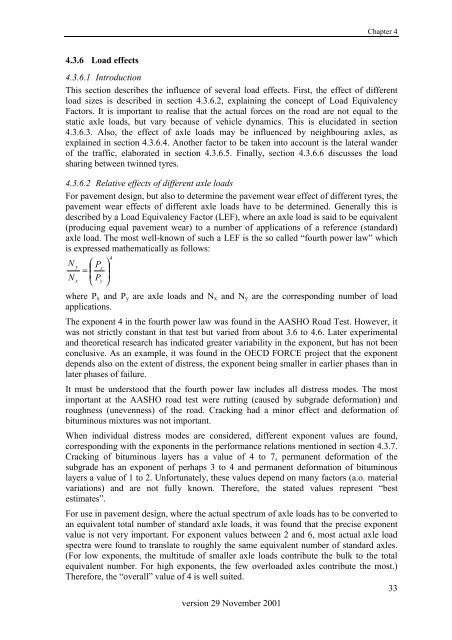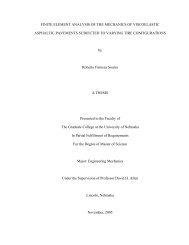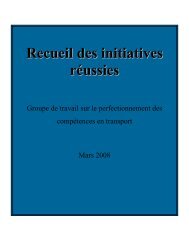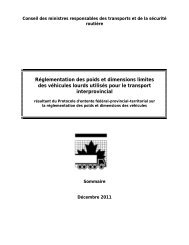Create successful ePaper yourself
Turn your PDF publications into a flip-book with our unique Google optimized e-Paper software.
Chapter 44.3.6 Load effects4.3.6.1 IntroductionThis section describes the influence of several load effects. First, the effect of differentload sizes is described in section 4.3.6.2, explaining the concept of Load EquivalencyFactors. It is important to realise that the actual forces on the road are not equal to thestatic axle loads, but vary because of vehicle dynamics. This is elucidated in section4.3.6.3. Also, the effect of axle loads may be influenced by neighbouring axles, asexplained in section 4.3.6.4. Another factor to be taken into account is the lateral wanderof the traffic, elaborated in section 4.3.6.5. Finally, section 4.3.6.6 discusses the loadsharing between twinned tyres.4.3.6.2 Relative effects of different axle loadsFor pavement design, but also to determine the pavement wear effect of different tyres, thepavement wear effects of different axle loads have to be determined. Generally this isdescribed by a Load Equivalency Factor (LEF), where an axle load is said to be equivalent(producing equal pavement wear) to a number of applications of a reference (standard)axle load. The most well-known of such a LEF is the so called “fourth power law” whichis expressed mathematically as follows:4Ny⎛ ⎞⎜Px= ⎟Nx ⎝ Py⎠where P x and P y are axle loads and N x and N y are the corresponding number of loadapplications.The exponent 4 in the fourth power law was found in the AASHO Road Test. However, itwas not strictly constant in that test but varied from about 3.6 to 4.6. Later experimentaland theoretical research has indicated greater variability in the exponent, but has not beenconclusive. As an example, it was found in the OECD FORCE project that the exponentdepends also on the extent of distress, the exponent being smaller in earlier phases than inlater phases of failure.It must be understood that the fourth power law includes all distress modes. The mostimportant at the AASHO road test were rutting (caused by subgrade deformation) androughness (unevenness) of the road. Cracking had a minor effect and deformation ofbituminous mixtures was not important.When individual distress modes are considered, different exponent values are found,corresponding with the exponents in the performance relations mentioned in section 4.3.7.Cracking of bituminous layers has a value of 4 to 7, permanent deformation of thesubgrade has an exponent of perhaps 3 to 4 and permanent deformation of bituminouslayers a value of 1 to 2. Unfortunately, these values depend on many factors (a.o. materialvariations) and are not fully known. Therefore, the stated values represent “bestestimates”.For use in pavement design, where the actual spectrum of axle loads has to be converted toan equivalent total number of standard axle loads, it was found that the precise exponentvalue is not very important. For exponent values between 2 and 6, most actual axle loadspectra were found to translate to roughly the same equivalent number of standard axles.(For low exponents, the multitude of smaller axle loads contribute the bulk to the totalequivalent number. For high exponents, the few overloaded axles contribute the most.)Therefore, the “overall” value of 4 is well suited.33version 29 November 2001






